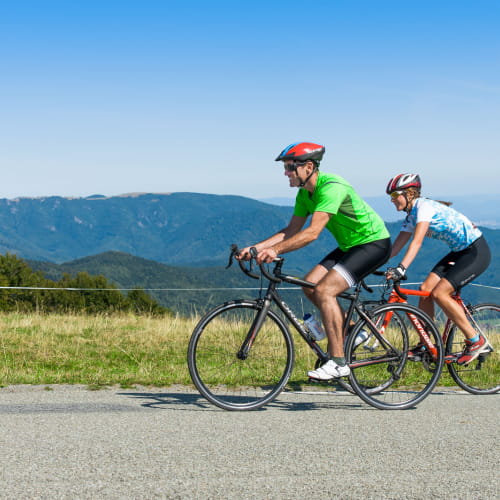
The Tour de France

The climb to the summit of the Ballon d'Alsace is one of 7 mountain passes on the "Historic Route of the Tour de France"
The Tour de France first crossed the Ballon d'Alsace in 1905 for the second edition of the race. Both that year and the next, René Pottier was the first rider over the summit, and even won the race. For this feat of arms (and pedals), Henri Desgranges, the head of the tour, had a memorial stone erected in Pottier’s honour not far from the summit.
It's a not-to-be-missed stop to pay homage to the "First king of the mountains". The Vosges Mountains certainly owe the cyclist the notoriety of the climb to the Ballon d'Alsace, recognised as a "Historic Route of the Tour de France" in 2019. It joined six other iconic French mountain passes. The climb starts at the Roche du Cerf in Lepuix (at an elevation of 549 m) and rises to the summit to reach a height of 1,173 m. Cycle tourists can ride in the tire treads of Tour de France champions along the route with 11 signs providing information to manage their efforts (distance, slope, and the history of the Tour de France).

Follow the champions and Gros Léon!
Granted the “Land of Cyclists” distinction by the French Cycling Federation, the Vosges Mountains lead the way in making popular mountain passes accessible and secure. A mid-sized mountain range, the Vosges are the perfect terrain for both beginners and future champions, with a few fun and challenging rides through the mountain passes of La Schlucht, Grosse Pierre, the Ballon d'Alsace, and Le Markstein.
Are you ready to compete against Christophe Mengin, a Vosges native and a professional cyclist and winner of the polka dot jersey in 2002? Stay in an accommodation with the Accueil Vélo label and explore the treasures of the Vosges Mountains on a time trial or while following the itinerary of a past race. Nowhere else will your efforts be more rewarded than with the breathtaking view of the blue line of the Vosges Mountains so dear to Jules Ferry. Are you an early riser? Marvel as the chamois saunter through the upper mountain pastures and the icy meadows of the summits. Then recharge your batteries with a delicious bilberry pie brimming with antioxidants. How about one last race with the favourite mascot of the Tour de France? At the head of the publicity caravan for 11 years, Gros Léon is the official sweeper truck of the race. And like any self-respecting athlete, he trains the rest of the year in the Vosges Mountains maintaining smooth roads for cyclists.
Will you be the champion of the stage in the Vosges Mountains?
Since 2012, La Planche des Belles Filles has hosted five stage finishes of the Tour de France, establishing itself as an essential stop for this legendary event. The mountain pass is certainly shorter than its neighbours with an ascent of only 6 km, but the climb is very difficult, with sections at 13% and a final wall with a slope of 20%.
It's a highly anticipated stage where great champions have won, including Christopher Froome, Vincenzo Nibali, and Tadej Pogacar. Are you ready to compete against these cycling greats?
While the climb is strenuous, it also boasts beautiful landscapes, like when the Ballon de Servance comes into view. La Planche des Belles Filles is worth the effort, with a rewarding and stunning view of the whole valley at the top.
And who knows, you just might cross paths with Thibaut Pinot, a local cyclist who trains on the roads in the area.
Ready to take up the challenge?













